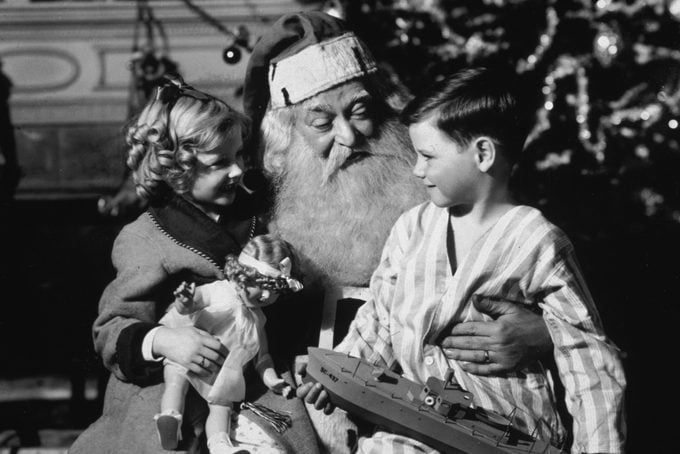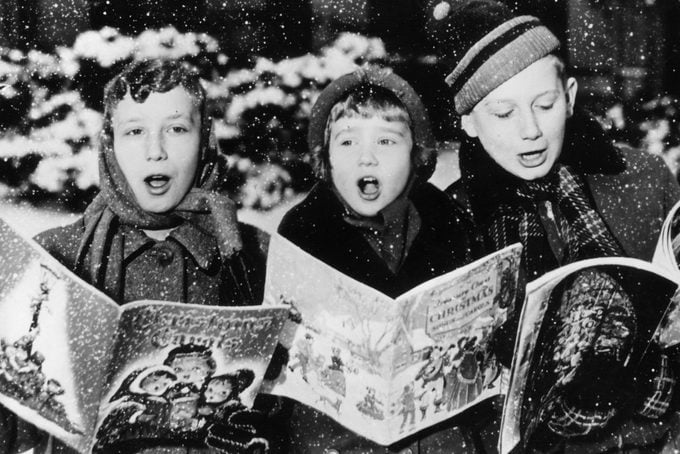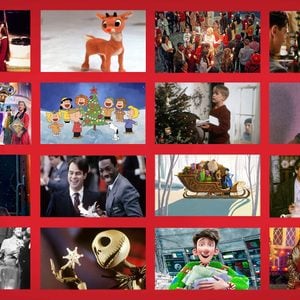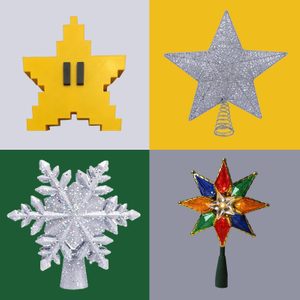What Is Christmas, and Why Do We Celebrate It?
Updated: Jul. 21, 2024

Christmas is America's No. 1 favorite holiday—85% of us celebrate it. Here's how Christmas started and why we have the traditions we do.
Crowds of people dressed up and going door-to-door while asking for treats and threatening mischief if the homeowners don’t pony up … sounds like Halloween, right? Actually, that was one popular way Christmas was celebrated during the Middle Ages! That’s right, our modern holiday—celebrated with Christmas traditions like gifts and trees and marked by Christmas symbols including stars and candy canes—is a far cry from how Christmas began.
So, what is Christmas all about, why do we celebrate Christmas and why is it celebrated in December? Before you start thinking of Christmas decoration ideas and your special mistletoe kiss, here’s everything you need to know about America’s most popular holiday.
What is Christmas?
Christmas is an annual sacred Christian holiday that commemorates the birth of Jesus Christ, the spiritual leader and founder of Christianity. While many people celebrate Christmas to honor Jesus’s birth, it’s also celebrated as a cultural holiday across the globe.
When is Christmas?
Christmas is always celebrated in America on the 25th of December, but the day of the week rotates. This year Christmas is on Wednesday, Dec. 25, 2024. Here are the days of the week Christmas falls on for the next three years:
- Thursday, Dec. 25, 2025
- Friday, Dec. 25, 2026
- Saturday, Dec. 25, 2027
Why is Christmas on Dec. 25?
So, why is Christmas on Dec. 25 each year? Many people think it’s because that was the day Jesus was born, but that’s actually false. The Bible doesn’t say when he was born, and the few clues we have—like shepherds guarding their flocks outside—hint that it may have been in the spring.
It wasn’t until three-and-a-half centuries after Christ’s birth that the date Dec. 25 was chosen to celebrate his birthday. Pope Julius I picked the date in 350 AD, and it was formalized in 529 AD, when Roman Emperor Justinian declared Christmas to be a civic holiday. (There is some controversy surrounding this timeline, and research into early Christian history is ongoing.)
The date wasn’t a random pick. Many historians believe that both the Pope and the Emperor liked this date because it coincided with the pagan festivals celebrating the winter solstice, which dated back centuries. (The winter solstice occurs Dec. 21 or 22, depending on the year.) Combining Christmas with these ancient celebrations allowed the church to keep the winter holiday tradition while refocusing the party on the “new” religion of Christianity; many of the pagan rituals were ditched in the process.
Choosing a date near the shortest day of the year may have also been symbolic, according to another theory. Each day afterward, the sun would grow progressively brighter, much like how the Christ child developed from infant to immortal.
Why is it called Christmas?
A big step in rebranding the old holiday was to give it a new, religious name. In fact, the word Christmas comes from Cristes maesse, Old English for “Christ’s Mass,” which references the Catholic tradition of holding a special mass ceremony to celebrate Jesus.
How did Christmas start?
Today, Christmas is both a religious and cultural holiday, centered around the birth of Jesus and celebrated all over the world. Midwinter celebrations, usually surrounding the winter solstice, were a staple of many different cultures. After Jesus died, early Christian celebrations focused mainly on his crucifixion and resurrection, so Easter was the original big Christian holiday.
However, about three centuries later, when the Christian church had become much larger and more influential, religious and political leaders wanted a way to make the Christian holidays more popular while still allowing for the traditional celebrations people already enjoyed. Combining Christmas and the winter solstice—even if it meant giving Jesus an arbitrary birth date, as mentioned above—was the solution.
As Christianity spread across the globe, so did the Christian holidays, including Christmas. From there, it became celebrated in a wide variety of ways as different cultures adapted it to their specific needs.
How did Christmas become the holiday we know today?

The early Christmas celebrations combined a mix of pagan and Christian traditions, resulting in activities that might seem more appropriate for Halloween these days: bonfires, trading treats for tricks and Mardi Gras–like bacchanals in the streets. It became so known for debauchery that the Pilgrims strongly discouraged celebrating it and even outlawed it in some cities when they first came to America.
Christmas wasn’t forgotten, but it didn’t start to regain popularity until the mid-1800s. Two very popular Christmas books at the time—Charles Dickens’s A Christmas Carol and Washington Irving’s The Sketchbook of Geoffrey Crayon, Gent.—portrayed Christmas in a warm, family-friendly way. Their recountings were mostly fictitious, but they kindled the imagination of Victorians. On June 26, 1870, President Ulysses S. Grant declared Christmas to be a U.S. national holiday.
In the 150 years since then, Americans have created their own unique celebration of Christmas by taking pieces from other cultural traditions and inventing some new ones. Many families have their own personal Christmas traditions, which add another layer of meaning and joy. There is still a religious component, and many people attend some type of church service either the night before or the day of, but most Christmas celebrations in America today focus on more secular activities. While 90% of Americans say they celebrate Christmas, fewer than half say they celebrate for religious reasons, according to a survey done by the Pew Research Center.
Let’s start with the most well-known, and perhaps most-loved, Christmas tradition: Santa Claus bringing gifts to children on Christmas Eve.
Santa Claus origin: Where did St. Nick come from?
The jolly old elf with the magical sleigh came from the story of a humble monk named St. Nicholas, who was born in Turkey around 280 AD. Monk St. Nicholas acquired his sainthood after giving away all his wealth to help the poor and the needy. He became known as the patron saint of children and had his own honorary day on Dec. 6.
Early Dutch immigrants to the United States, however, get credit for the name Santa Claus. They brought with them their cultural tradition of celebrating the saint’s death. They called him “Sint Nikolaas” (Dutch for Saint Nicholas) and abbreviated it to “Sinter Klaas,” which has since evolved into Santa Claus.
The main characteristics of the Santa story—his jolly personality, gifts, a naughty-or-nice list, reindeer and chimney shenanigans—were put into place by the 1822 poem written by Episcopal minister Clement Clarke Moore. The poem is called “An Account of a Visit from St. Nicholas,” but you likely know it by its iconic first line: “‘Twas the night before Christmas …”
You can thank Coca-Cola for the last component, the grandfatherly style of Santa Claus. Coke’s early-1900s advertising featured a warm, happy elderly man with rosy cheeks, a white beard and twinkling eyes. It was so popular that it became the default image of Santa, who’s now the central character in many Christmas books and Christmas movies for kids.
Popular Christmas traditions
Of course, Santa isn’t the only popular Christmas tradition. In fact, you might find yourself wondering, What is Christmas without these holiday favorites?
Watching Christmas movies
Movies with Christmas themes are some of the highest-grossing films of all time, and families often love watching them together as part of their holiday celebrations.
Singing Christmas carols

“Raising a joyful noise” (in tune or otherwise!) is a favorite Christmas tradition for many. There’s just something special about singing these Christmas songs, especially when you go caroling with a group of loved ones.
Decorating Christmas trees
The tradition of cutting down an evergreen tree, setting it up indoors and decorating it for Christmas originated in Germany in the 16th century. Since then, it’s become one of the most well-loved holiday traditions of all time, whether you have a real or artificial tree.
Giving gifts
There are many ways to show your love for others during the holiday season, and giving gifts is a popular one. The tradition of gift-giving is said to be a reminder of the gifts the three wise men brought to the baby Jesus.
Decking your halls (and everything else)
Decorating your home, yard, office, car or even yourself is a great way to bring a festive, happy touch to the dark days of winter. Many people love making their own Christmas decorations, stringing up twinkly lights, hanging a round evergreen wreath on the door and sporting funny ugly Christmas sweaters to bring the holiday cheer.
Creating a festive dinner table
A sumptuous feast is made even more appealing when it’s placed on a beautiful tablecloth or a table laid out with festive decorations.
Eating popular Christmas food

What is Christmas without traditional Christmas foods? Each culture and family have their own special menus, but here are some of the most popular treats and traditions.
Christmas cookies
Whether you bake them to share with others or for your own enjoyment, nothing says “It’s the holidays” like the smell of freshly baked Christmas cookies.
Honey ham
A spiral-cut glazed ham is a popular centerpiece for Christmas dinner, and we pretty much guarantee that the whole family will love these Christmas ham recipes. Roasted turkey is another popular option.
Candy canes
These minty red-and-white-striped confections are a staple for both decorating and eating. They’re just one of the Christmas candies you can only find around the holidays.
Christmas fun facts
When you’re not making your loved ones laugh around the dinner table with these Christmas jokes, regale them with these interesting facts about Christmas. (Trust us: These conversation starters will come in handy!)
- 85% of people in the U.S. said they planned to celebrate Christmas in 2022.
- No one likes dropped pine needles. According to a survey done by Statista, 71% of respondents said they planned on putting up a Christmas tree in 2022; however, only 24% of those respondents said they were putting up a real tree. The other 47% said they were opting for fake trees.
- People like to get ahead with their Christmas shopping. According to the National Retail Federation, 61% of consumers start Christmas shopping by early November. If you’re a shopping procrastinator, don’t worry—these stores are open on Christmas Day.
- Count ’em up: Your true love gives you 364 gifts total, according to “The 12 Days of Christmas” song—that’s one every day of the year … except Christmas.
- We love our minty treats: Nearly 2 billion candy canes are sold every year in the four weeks before Christmas, and the longest candy cane ever created was 51 feet long.
- Christmas carols know no bounds: “Jingle Bells” was the first song ever played from outer space when it was broadcast during NASA’s Gemini 6A space flight in December 1965.
- Shop in your jammies: More than 60% of U.S. shoppers prefer to skip the stores and buy their holiday gifts online.
Sources:
- Biblical Archaeology Society: “How December 25 Became Christmas”
- Cambridge University: “The Origins of the Christmas Date: Some Recent Trends in Historical Research”
- Baylor University: “The Birth of Christmas”
- Statista: “U.S. Christmas season – Statistics & Facts”
- National Retail Federation: “Retail Holiday and Seasonal Trends: Winter Holidays”





































